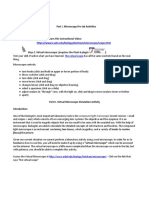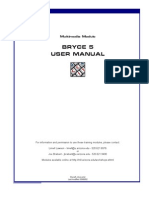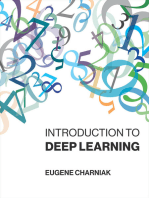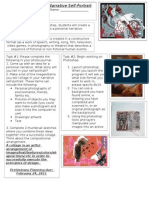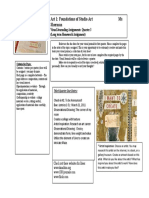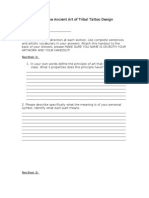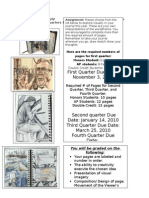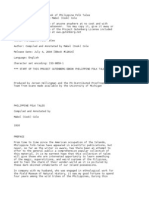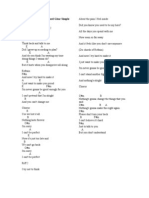Photogram Handout
Photogram Handout
Uploaded by
shermjCopyright:
Available Formats
Photogram Handout
Photogram Handout
Uploaded by
shermjCopyright
Available Formats
Share this document
Did you find this document useful?
Is this content inappropriate?
Copyright:
Available Formats
Photogram Handout
Photogram Handout
Uploaded by
shermjCopyright:
Available Formats
Photography 1: Introduction to Photography
"Captured Shadows"
"The shadows that things make, the things that shadows
make"
What is a Photogram?
A photogram is a photographic image made without a camera by
placing objects directly onto the surface of a photo-sensitive material
such as photographic paper and then exposing it to light.
Art Problem:
• Create a series of 3 photogram prints that are unified
compositionally through common elements and principles of
design.
Below please fill in two elements you will explore in order to create the
principle of design. For example: ( Line + Value= Movement)
___________________+___________________=________________________
Element Element Principle
Preliminary Planning:
You have brought in your objects now you
will need to do the following:
1. Make a small drawing (4" X 5") in
your sketchbook of each object
and make a list of 10 qualities or
characteristics of the object
(smooth, solid, clear, shiny,
bumpy, ugly, squishy).
2. Using the specific elements to
make a specific principle
compose a thumbnail of each of
the 3 compositions in your
journal. This will help you plan
your arrangement. These 3
thumbnails will be done in class
before you make your photogram
photographs.
In The Darkroom…..
First:
Arrange your objects into
an interesting composition
that demonstrates your
chosen elements and
principles of design. Refer
to your thumbnail sketches!
Remember! Second! Make a Test Strip.
1. Make visual pathways
2. Break
Experiment! up positive
Please completeand1 photogram print where you experiment
What is the correct procedure for with
negative
the following spaces
techniques. making a test strip? Now would be the
time to review.
3.aProvide
What is Multiple a variety of
Exposure?
A multiplesized shapes/line
exposure is created when more than one exposure is made
Adjust enlarger aperture to upon
F8 or aF11.
weight
photographic surface at a time. Set your timer for 2-3 second intervals.
Filltrying
When the frame!
a multiple exposure please consider the risk of overexposure ( you can
avoid this by using a smaller aperture that lets
Cut ainpiece
less light or a shorter
of photo exposure
paper into a strip.time.
Third. Arrange your objects over top the
Giving
Make the Illusion
a properly of Movement……..
exposed print. In your paper, either in a standard easel or a
Movementplease
sketchbook can berecord
madeAperture
in both implied
and and literal printer.
contact ways. By using multiple exposures
of an object movement can be suggested.
exposure times for each print you make. As the artist you can also literally roll an
object or move an object during the exposure time.
You might also like
- Lab Report Fundamentals of MicrosDocument15 pagesLab Report Fundamentals of MicrosKyle DunnNo ratings yet
- Sons of IssacharDocument4 pagesSons of Issacharpslafrika100% (1)
- OphielDocument1 pageOphielharieswaranNo ratings yet
- LAB 3 - Use of The MicroscopeDocument20 pagesLAB 3 - Use of The MicroscopeLexie KepnerNo ratings yet
- Arkitekturang Filipino 3 - Spectacle of Power - Hispanic St...Document2 pagesArkitekturang Filipino 3 - Spectacle of Power - Hispanic St...ISABELLE MAXINE MANTONo ratings yet
- Thesis Paper - Artists StereotypesDocument11 pagesThesis Paper - Artists Stereotypesapi-277000772No ratings yet
- Principles of Physical Chemistry - Answers To Problems (Book, 1965) (WorldCat - Org) PDFDocument2 pagesPrinciples of Physical Chemistry - Answers To Problems (Book, 1965) (WorldCat - Org) PDFCindy Gallos0% (1)
- Julia Annas, Gábor Betegh - Cicero's de Finibus - Philosophical Approaches-Cambridge University Press (2015) PDFDocument274 pagesJulia Annas, Gábor Betegh - Cicero's de Finibus - Philosophical Approaches-Cambridge University Press (2015) PDFJose D.C. Garrido FuchslocherNo ratings yet
- Grammar-Land WorksheetsDocument18 pagesGrammar-Land WorksheetsKimberly Culver100% (2)
- Making A PhotogramDocument1 pageMaking A PhotogramelalondeNo ratings yet
- Microscope Skills Activity (F)Document4 pagesMicroscope Skills Activity (F)Mark Vincent BuenoNo ratings yet
- Microscopic IntroDocument5 pagesMicroscopic IntrotamilkumaransaravankumarNo ratings yet
- Blender Question BankDocument7 pagesBlender Question BankNachiket PathakNo ratings yet
- Lighting Camera MaterialsDocument47 pagesLighting Camera MaterialsNermeen ElsheikhNo ratings yet
- After Effects - 3D Picture TrickDocument8 pagesAfter Effects - 3D Picture TrickUnderseen100% (3)
- Week 3 Microscopes & Magnification (Miss Alya)Document23 pagesWeek 3 Microscopes & Magnification (Miss Alya)Kausika ThanarajNo ratings yet
- WEEK 5 Still Life DrawingDocument22 pagesWEEK 5 Still Life DrawingJJ PonsicaNo ratings yet
- 7304 BRIEF-4f Cinematic ReflectionsDocument3 pages7304 BRIEF-4f Cinematic ReflectionsBakka SilvaNo ratings yet
- 5.1 Microscope Skills ActivityDocument6 pages5.1 Microscope Skills ActivityDean JezerNo ratings yet
- Project 4-2Document1 pageProject 4-2api-324501893No ratings yet
- Lesson 2: Animation Basics: ObjectivesDocument8 pagesLesson 2: Animation Basics: ObjectivesAnonymous zrAfrkPOJ7No ratings yet
- How To Use A Light MicroscopeDocument4 pagesHow To Use A Light MicroscopebasondesaNo ratings yet
- Project 3-152-2Document1 pageProject 3-152-2api-324501893No ratings yet
- Lab 2 MicrosDocument15 pagesLab 2 Microsjohn NisNo ratings yet
- Lab+3A+Microscope+%28instructions%29Document2 pagesLab+3A+Microscope+%28instructions%29diazvalerie434No ratings yet
- Demo LPDocument5 pagesDemo LPPerlita CarpenteroNo ratings yet
- Virtual Laboratory Microscope SimulationDocument4 pagesVirtual Laboratory Microscope SimulationNicole CabrigasNo ratings yet
- Hand Out For OpticsDocument19 pagesHand Out For OpticsnidharshanNo ratings yet
- 2014 Phillip Reu All About Speckles AliasingDocument3 pages2014 Phillip Reu All About Speckles AliasingGilberto LovatoNo ratings yet
- Science 7 q2 m1 - PDF FILEDocument6 pagesScience 7 q2 m1 - PDF FILEEzzel Jan FranciscoNo ratings yet
- 10steps Perfect ImbDocument14 pages10steps Perfect ImbFernando Costa PereiraNo ratings yet
- 8B - Lab 4 - Mirrors, Lenses and Optical InstrumentsDocument11 pages8B - Lab 4 - Mirrors, Lenses and Optical InstrumentsjeremiahshimNo ratings yet
- How To Use A Microscope PowerPointDocument16 pagesHow To Use A Microscope PowerPointFatima ElsahliNo ratings yet
- Pintar Optics Quick Start TutorialDocument15 pagesPintar Optics Quick Start TutorialTitus DascaluNo ratings yet
- Bryce 5 User Manual: Multimedia ModuleDocument11 pagesBryce 5 User Manual: Multimedia ModuleGuenter HeleNo ratings yet
- SC7 The-EyeDocument2 pagesSC7 The-EyeRuchi NairNo ratings yet
- Microscope BasicsDocument15 pagesMicroscope Basicschadling.jim23No ratings yet
- Bio3 Lab5 - Microscopy and Cells-8eDocument20 pagesBio3 Lab5 - Microscopy and Cells-8ekrae tradiskanaNo ratings yet
- Computer Vision - Ipynb - ColaboratoryDocument17 pagesComputer Vision - Ipynb - Colaboratoryzb laiNo ratings yet
- Dissecting and Compound Edit PDFDocument15 pagesDissecting and Compound Edit PDFkhaledalrjiNo ratings yet
- Lab 1 GEO OpticsDocument22 pagesLab 1 GEO OpticsANDREYY GORYACHEVNo ratings yet
- Lab 2 Microscopy and Biological MolecDocument18 pagesLab 2 Microscopy and Biological MolecAndrew MartiniNo ratings yet
- Worksheet: Images in Plane MirrorsDocument2 pagesWorksheet: Images in Plane MirrorssenjicsNo ratings yet
- Edited - OPTICS LESSON 5: More On Laws of Reflection and Finding Images in A Plane MirrorDocument2 pagesEdited - OPTICS LESSON 5: More On Laws of Reflection and Finding Images in A Plane Mirrorcatcat2100catcatNo ratings yet
- Microscope Lab - SKIN AND ONION CELLSDocument5 pagesMicroscope Lab - SKIN AND ONION CELLSh4rpnj25ftNo ratings yet
- 3.1 MicroscopeBasicsDocument22 pages3.1 MicroscopeBasicsJamaica Salas SuacilloNo ratings yet
- 3D Modeling Course - OutlineDocument5 pages3D Modeling Course - OutlineNika BellosilloNo ratings yet
- Lesson Plan For Final DemoDocument8 pagesLesson Plan For Final DemoCetura VillaruzNo ratings yet
- The Kid Stays in The (Moving) Picture: Tips N TricksDocument3 pagesThe Kid Stays in The (Moving) Picture: Tips N TricksNick CalpakdjianNo ratings yet
- Grade 10 Quarter 2, Week 6: Title CardDocument30 pagesGrade 10 Quarter 2, Week 6: Title CardJeboy LaquianNo ratings yet
- Datos de Cosas InteresantesDocument16 pagesDatos de Cosas InteresantesManolo CaracolNo ratings yet
- How To Take Good Pictures With Your PhoneDocument17 pagesHow To Take Good Pictures With Your PhonehiNo ratings yet
- Unplug 2Document23 pagesUnplug 2api-271553287No ratings yet
- Microscope and Specialised CellsDocument37 pagesMicroscope and Specialised Cellssulafa abbaselhassanNo ratings yet
- Activity #11: Lens Lab Part 1. Image FormationDocument4 pagesActivity #11: Lens Lab Part 1. Image FormationJuan Carlos Mejia MaciasNo ratings yet
- Evaluation SheetDocument2 pagesEvaluation SheetRowena Matte FabularNo ratings yet
- Activity Guide - MicrosDocument5 pagesActivity Guide - MicrosJazel SalesNo ratings yet
- Chapter Convolutional Neural NetworksDocument7 pagesChapter Convolutional Neural NetworksRAKESH SWAINNo ratings yet
- Science-7-Week-2 20Document20 pagesScience-7-Week-2 20Tricia BrunoNo ratings yet
- Chemistry Workshops and Investigations: Make A DVD Smartphone SpectrometerDocument19 pagesChemistry Workshops and Investigations: Make A DVD Smartphone SpectrometerAli BretNo ratings yet
- Manual ENGbw FinalDocument8 pagesManual ENGbw FinalProfAntonio FranciscoNo ratings yet
- Does The Brain Do Inverse Graphics?Document49 pagesDoes The Brain Do Inverse Graphics?Made ArthaNo ratings yet
- Using Compound and Dissecting Microscopes ObjectivesDocument4 pagesUsing Compound and Dissecting Microscopes ObjectivesAdam LopezNo ratings yet
- Fine Art Flower Photography: Creative Techniques and the Art of ObservationFrom EverandFine Art Flower Photography: Creative Techniques and the Art of ObservationRating: 4 out of 5 stars4/5 (1)
- The Visual Elements—Photography: A Handbook for Communicating Science and EngineeringFrom EverandThe Visual Elements—Photography: A Handbook for Communicating Science and EngineeringNo ratings yet
- The Enthusiast's Guide to Multi-Shot Techniques: 49 Photographic Principles You Need to KnowFrom EverandThe Enthusiast's Guide to Multi-Shot Techniques: 49 Photographic Principles You Need to KnowNo ratings yet
- Collage NarrativeDocument1 pageCollage NarrativeshermjNo ratings yet
- Portrait Without A FaceDocument1 pagePortrait Without A FaceshermjNo ratings yet
- Third QuarterDocument1 pageThird QuartershermjNo ratings yet
- Exploring Texture: Criteria For Your Texture ExampleDocument5 pagesExploring Texture: Criteria For Your Texture ExampleshermjNo ratings yet
- RubricDocument1 pageRubricshermjNo ratings yet
- BCR HandoutDocument2 pagesBCR HandoutshermjNo ratings yet
- Visual Journals: First QuarterDocument1 pageVisual Journals: First QuartershermjNo ratings yet
- Journal Topics 2010Document2 pagesJournal Topics 2010shermjNo ratings yet
- Photography 1 MHHS SyllabusDocument4 pagesPhotography 1 MHHS SyllabusshermjNo ratings yet
- Romansque ArchitectureDocument45 pagesRomansque ArchitectureKreya Patel100% (1)
- Philippine Folk TalesDocument113 pagesPhilippine Folk TalesGutenberg.org100% (26)
- 8dio Alien Drum Read MeDocument9 pages8dio Alien Drum Read MeSteal YourfaceNo ratings yet
- Digital Image Processing: Lecture # 2 FundamentalsDocument41 pagesDigital Image Processing: Lecture # 2 FundamentalsRaaz KhanNo ratings yet
- Countries and Nationalities 1 Vocabulary Exercise WorksheetDocument2 pagesCountries and Nationalities 1 Vocabulary Exercise WorksheetRoxana Mușeat100% (1)
- Cat in The Rain by Ernest HemingwayDocument6 pagesCat in The Rain by Ernest HemingwaylalyitaNo ratings yet
- Geeky Nerdy PDFDocument1 pageGeeky Nerdy PDFc0d3rNo ratings yet
- Heroism: A Conceptual Analysis and Differentiation Between Heroic Action and Altruism - Franco, Blau & Zimbardo 2011Document15 pagesHeroism: A Conceptual Analysis and Differentiation Between Heroic Action and Altruism - Franco, Blau & Zimbardo 2011Zeno FrancoNo ratings yet
- Full Band Camp Schedule1Document2 pagesFull Band Camp Schedule1api-259913992No ratings yet
- New Editing StylesDocument221 pagesNew Editing StylesvirendhemreNo ratings yet
- Ellen's Message in The CardsDocument2 pagesEllen's Message in The CardsRevelation717No ratings yet
- WOD - Werewolf - The Apocalypse - Character Sheet - NagahDocument4 pagesWOD - Werewolf - The Apocalypse - Character Sheet - NagahLavaeolous 1No ratings yet
- 10 Useful Typography Tips For Adobe IllustratorDocument34 pages10 Useful Typography Tips For Adobe IllustratorServicios TSM TSM100% (1)
- Jogos n64Document3 pagesJogos n64Matheus GerminoNo ratings yet
- Contests of Text and Context in Chinua Achebe's 'Arrow of God'Document16 pagesContests of Text and Context in Chinua Achebe's 'Arrow of God'Chiara Zwicky SarkozyNo ratings yet
- Elements of Hungry ArtistDocument4 pagesElements of Hungry ArtistMika JusayNo ratings yet
- Jambhala FinalDocument14 pagesJambhala Finalmaniakunuri2No ratings yet
- Nepalese Translation 01Document121 pagesNepalese Translation 01abiskar0% (1)
- Lyric, Chords Guitar, Kord Gitar Simple Plan - PerfectDocument4 pagesLyric, Chords Guitar, Kord Gitar Simple Plan - PerfectDwi SulistriyaniNo ratings yet
- Strong: Words and Music by Hannah Reid, Dominic Major and Daniel RothmanDocument4 pagesStrong: Words and Music by Hannah Reid, Dominic Major and Daniel RothmanNienke van HorenNo ratings yet
- Price ListDocument61 pagesPrice Listdonna benito100% (1)
- Introduction To Environmental ManagementDocument60 pagesIntroduction To Environmental ManagementKarla Charmagne BeatoNo ratings yet
- Natsu Koi MonogatariDocument2 pagesNatsu Koi MonogatariKartika WijayantiNo ratings yet


























